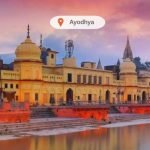Discover the spiritual charm of Varanasi with our Varanasi Ghats tour guide. Experience the captivating Ganga Aarti, explore historic ghats, and immerse yourself in the rich cultural heritage.
Varanasi, also known as Kashi or Benares, is one of the oldest living cities in the world and is deeply interwoven with the sacred Ganges River. The city’s ghats—stepped embankments leading to the river—are the heart and soul of Varanasi, where life and spirituality converge. A Varanasi ghats tour offers a unique opportunity to witness the city’s daily rituals, explore its ancient temples, and immerse yourself in its vibrant culture. Here are the key highlights and experiences of a comprehensive ghats tour in Varanasi.
The Significance of Varanasi’s Ghats
Varanasi’s ghats are more than just physical structures; they are the spiritual arteries of the city. Each of the more than 80 ghats has its own unique history, significance, and set of rituals. From the bustling Dashashwamedh Ghat to the serene Assi Ghat, these riverbanks offer a window into the soul of Varanasi. Pilgrims come here to perform religious rituals, take holy dips, and seek spiritual solace, making the ghats a hub of constant activity.
Dashashwamedh Ghat
Dashashwamedh Ghat is the most prominent and busiest ghat in Varanasi. It is believed to be the site where Lord Brahma performed the Dasa Ashwamedha sacrifice. The ghat is famous for the daily Ganga Aarti, a spectacular evening ritual where priests perform synchronized prayers with lamps, incense, and music. The aarti is a mesmerizing experience that attracts both devotees and tourists, creating a vibrant and spiritual atmosphere.
Assi Ghat
Assi Ghat, located at the southern end of the city, is where the Assi River meets the Ganges. Known for its tranquility, Assi Ghat is a popular spot for yoga and meditation sessions, often held at sunrise. It is also a cultural hub, hosting various events, music performances, and festivals. The serene environment and the panoramic view of the river make it a perfect place to relax and soak in the spiritual ambiance.
Manikarnika Ghat
Manikarnika Ghat is one of the most significant and oldest ghats in Varanasi, known as the primary cremation site. According to Hindu belief, those who are cremated here attain moksha, or liberation from the cycle of rebirth. The ghat is constantly active with funeral pyres, and the solemn rituals performed here offer a profound insight into the Hindu beliefs about life and death.
Harishchandra Ghat
Harishchandra Ghat is another important cremation ghat, named after the mythological King Harishchandra, who is said to have worked here as a cremator to fulfill his promise of truth. Like Manikarnika, this ghat is deeply associated with the Hindu funeral rites. The constant activity at Harishchandra Ghat provides a poignant reminder of the transient nature of life.
Tulsi Ghat
Tulsi Ghat is named after the famous poet Tulsidas, who is believed to have composed the Ramcharitmanas here. The ghat is known for its association with literature and culture. It hosts various cultural programs, including the annual Ramlila performance, which reenacts the life of Lord Rama. Tulsi Ghat is a place where spirituality and culture blend seamlessly.
Scindia Ghat
Scindia Ghat, also known as Shinde Ghat, is famous for its partially submerged Shiva temple, which is believed to have collapsed in the early 19th century. The ghat is quieter and less crowded, offering a peaceful atmosphere for those seeking solitude. The architectural beauty and the serene environment make Scindia Ghat a hidden gem among Varanasi’s ghats.
Raj Ghat
Raj Ghat marks the northern boundary of Varanasi’s ghats. It is an important historical site, believed to be where the ancient city of Kashi was founded. The ghat is less frequented by tourists, making it a tranquil spot to explore the historical and spiritual layers of Varanasi.
Exploring the Rituals and Traditions
A Varanasi ghats tour is incomplete without witnessing the various rituals and traditions performed along the riverbanks. From the early morning ablutions to the evening aarti, the ghats are a stage for a myriad of spiritual practices. Pilgrims come to perform pujas (prayers), offer diyas (lamps) to the river, and chant hymns. These rituals are deeply rooted in the city’s spiritual heritage and offer a fascinating glimpse into the daily life of Varanasi.
Boat Ride on the Ganges
One of the best ways to explore the ghats is by taking a boat ride on the Ganges. A sunrise boat ride offers a serene and beautiful view of the ghats bathed in the soft morning light, while an evening ride provides a mesmerizing sight of the ghats illuminated by the aarti lamps. Boat rides allow you to see the ghats from a unique perspective and capture the essence of Varanasi’s spirituality and culture.
Interacting with Sadhus and Priests
The ghats of Varanasi are frequented by sadhus (holy men) and priests, who are often approachable and willing to share their knowledge and insights about the city’s spiritual significance. Interacting with these spiritual guides can provide a deeper understanding of the rituals and beliefs that define Varanasi. Many sadhus are happy to explain the significance of the ceremonies and offer blessings to visitors.
Sampling Local Delicacies
While exploring the ghats, don’t miss the opportunity to sample Varanasi’s local delicacies. The street food stalls near the ghats offer a variety of delicious snacks like kachori sabzi, tamatar chaat, and the famous Banarasi paan. These culinary delights add a flavorful dimension to your ghats tour, allowing you to savor the tastes of Varanasi.
Photography Tips
The ghats of Varanasi offer countless opportunities for photography. Here are a few tips to capture the essence of your ghats tour:
- Early Morning Light: The soft, golden light of early morning is perfect for capturing the serene beauty of the ghats.
- Evening Aarti: The Ganga Aarti is a spectacular event to photograph, with its vibrant colors and dynamic rituals.
- Street Scenes: Capture the candid moments of daily life along the ghats, from pilgrims performing rituals to locals going about their day.
- Reflections: The reflections of the ghats and temples in the Ganges create stunning photographic compositions.
Conclusion
A Varanasi ghats tour is a journey through the spiritual heart of India. From the bustling activity of Dashashwamedh Ghat to the solemn rituals at Manikarnika, each ghat offers a unique experience that reflects the city’s deep spiritual roots and vibrant culture. Whether you’re observing the rituals, taking a boat ride, or simply soaking in the atmosphere, the ghats of Varanasi provide an unforgettable experience that connects you to the timeless essence of this ancient city.
FAQs
What is the best time to visit the ghats in Varanasi?
The best times to visit the ghats in Varanasi are during the early morning hours for a serene atmosphere and during the evening for the Ganga Aarti ceremony.
Can I take a boat ride on the Ganges?
Yes, boat rides on the Ganges are a popular way to explore the ghats. You can choose from sunrise, daytime, or evening rides to experience the ghats from different perspectives.
Which ghat is known for the Ganga Aarti?
Dashashwamedh Ghat is renowned for the Ganga Aarti, a daily ritual that attracts large crowds of devotees and tourists.
Are there any guided tours available for the ghats?
Yes, guided tours are available and can provide valuable insights into the history, significance, and rituals of the ghats.
What should I wear when visiting the ghats?
It is recommended to wear modest and comfortable clothing when visiting the ghats. Respecting the local customs and traditions is important.
Is it safe to visit the ghats at night?
While the ghats are generally safe, it is advisable to visit with a group or guide, especially at night, and to stay in well-lit and populated areas.




